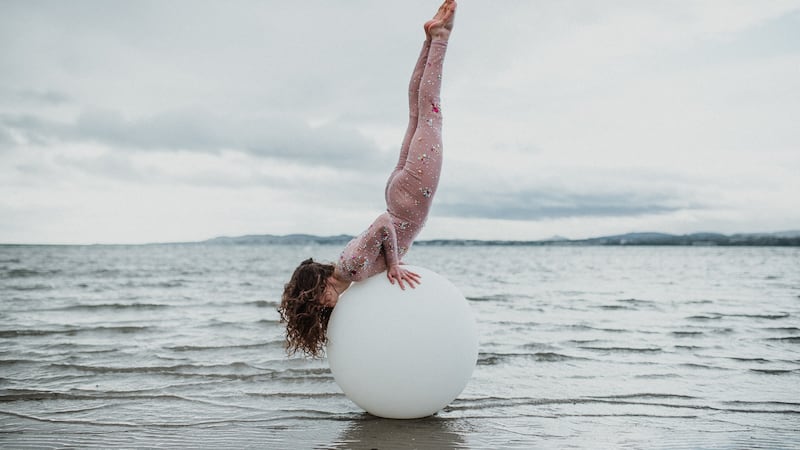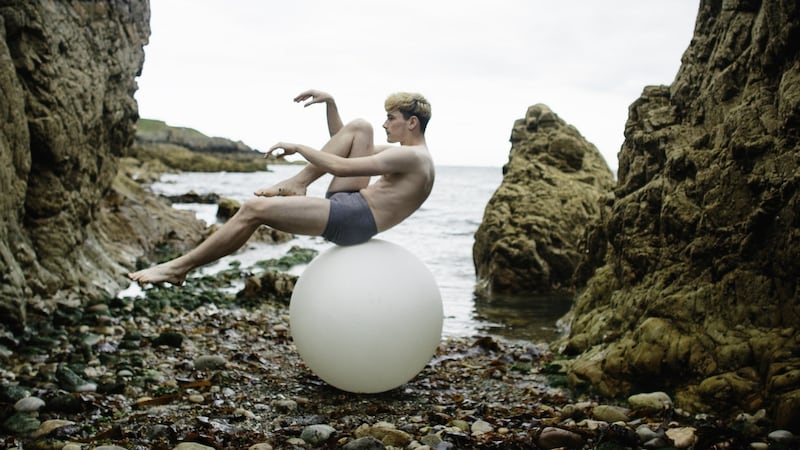A conversation with Emily Aoibheann about her latest work, Mother of Pearl, is a bit like her artistic life to date: rambling, intriguing, but never dull. Walking along the rocks and hidden beaches on the south coast of Howth peninsula – a landscape that inspired Mother of Pearl – she explains the ideas and ideals that shape her art-making, drawing on analogies and examples from performance practice, bio-architecture, myth and hauntology.
She was a founding member of the aerial dance collective Paper Dolls, but is increasingly reluctant to categorise herself as just an aerial dancer. She has gigged as a drummer in Berlin, written plays and these days describes herself as a transdisciplinary artist.
“Aerial dance and circus arts are my expertise,” she says. “But as an aerialist, people put you in a box like an entertainer. You are a performing spectacle. I see myself more as someone who uses its tools and moves from one artform to another. I know what it is like to train and demonstrate a skill. That’s a known outcome. I’m much more interested in the unknown.”
Veering from the official pathways of Howth peninsula is a wildness at odds with the nearly suburban streets, and it is this co-existence and tension between wildness and domesticity that underpins her recent artistic output. Mother of Pearl is the second of two works that investigate nature and civilisation, coming after Sorry Gold, which received award nominations and five-star reviews at this year's Dublin Fringe Festival.
“I feel that I need more wildness,” she says. “It is genuinely emotional for me right now.” For wildness, also read risk. Aoibheann constantly feels the need to push herself into new ways of expressing her ideas. Not only does she work outside specific genres, she also works at a physical remove from others. Although she has been resident in various venues around Dublin – The Complex in Smithfield, D-Light Studios on North Great Clarence Street and DanceHouse on Foley Street– she is happiest in her own studio in Cabra.
‘Reconnect with the earth’
“It is like a warehouse space, and can be cold, but I love the fact that I can do what I want. There is no health and safety red-tape, protocol or formality. It is somewhere I can privately take risks as an artist. You just shut the door and nobody knows what’s going on inside.”
Along the walk in Howth, she points out a pink pebbled beach, strangely lit with morning sunlight, and rocks that look like muscles and bodies. The landscape might have inspired her, but she met it half-way.
"I felt like I needed to reconnect with the earth," she says. In particular, she was drawn to the ideas of bio-architect Rachel Armstrong, professor of experimental architecture at Newcastle University.
“She is imagining ways we can use biology in architecture to give inert objects life. We are trapped in a paradigm of Victorian technology and are still thinking of the machine to fix problems. And this means that we are continuing to create inertness. Instead she sees a need to switch to the microbial.”
So rather than construct an engineering solution to the problem of Venice sinking into the sea, Armstrong proposes a biological solution. “She has drawn up models to creating a protocell that would grow on the wooden structure that supports the city and creates a coral island underneath.”

This thinking mirrors Aoibheann’s own drifting away from the nuts and bolts of circus arts into less mechanical ways of expressing herself. Mother of Pearl contains music that she wrote 10 years ago, as well as inputs from fellow collaborators, such as designers Laura Fajardo and Liing Heaney, sound designer Peter Power and choreographer Megan Kennedy.
“Ling works a lot in 3-D geological art and she has created a giant pearl, which is like a hyper-object from a post-natural age,” she says. This, and the other objects on stage, aren’t just set design, but are intrinsic to the movement. “So even if there were no performers, the objects themselves would be a performance, a bit like Bauhaus.”
Liing Heaney’s giant pearl is rich with suggestive allusion. When a grain of sand gets washed into an oyster, the irritation causes the oyster to create a pearl to form a seal around the irritant. This presence of a benign outsider seen as an irritant evokes Aoibheann’s thoughts around conformity and difference, and her own presence as an outsider and agitating artist.
Hero’s journey
She was also drawn to the pearl’s beauty. “So much performance art I’ve explored was into ugliness. I’m happy now to be reclaiming beauty, as a natural thing, not artificial.” However beautiful, the act of extracting the pearl kills the oyster and Aoibheann poses similar question on how we value art. Do we focus on the object or its natural place in a real or metaphoric ecology?
Along with Megan Kennedy she is working with two hand balancers – Cathi Sell and Becky Neal – to devise geologically-inspired movement. “I call them avalanches, these slow, very muscular contortionist balances, which evoke feelings of depressiveness.”
The Greek god Pan is depicted by dancer Michael Gillick, embodying a wildness unhindered by confines of civilisation. “I see him more like Nijinsky than the traditional image. He’s a more youthful Pan, more androgynous.”

During the creation of Mother of Pearl, time became an essential element. “There is human time, like the 10 years since I composed the music. Can I take the spirit of that time and recreate it now? “Then there is geological time, interacting and dancing with rocks. And finally, mythological time.
“We have taken the story of the Greek god Pan and imagined him taking a hero’s journey, leaving the familiar to go into the unknown.”
This finds resonance in today’s society. “I’ve been thinking about this a lot, because there has been a huge surge in people taking a similar hero’s journey and having nothing to return to. We are pursuing, but we don’t have the root to return to. That’s a genuine feeling for a lot of people.”
Is that root to be found in nature, the balm of our technological stress? Didn’t we emerge from nature, gradually grow distant from it and now reconnect with it? It is a simplistic notion that has been challenged by the ecological philosopher Timothy Morton.
“Up until recently we’ve had this idea that nature and civilisation are two parts of a whole and there is a very distinct separation between the two. Morton suggests that nature is inseparable from civilisation,” says Aoibheann. In Ecology Without Nature, Morton writes: “Putting something called Nature on a pedestal and admiring it from afar does for the environment what patriarchy does for the figure of woman. It is a paradoxical act of sadistic admiration.”
Aoibheann is ready to apply such fundamental rethinks of nature to her art, spurning spectacle and superficial rhetoric for creative investigation. “Maybe it is trendy to be politically oriented, but I think the really radical thing is the radical imaginary.”
Mother of Pearl runs November 7th to 9th at Project Arts Centre, Dublin











